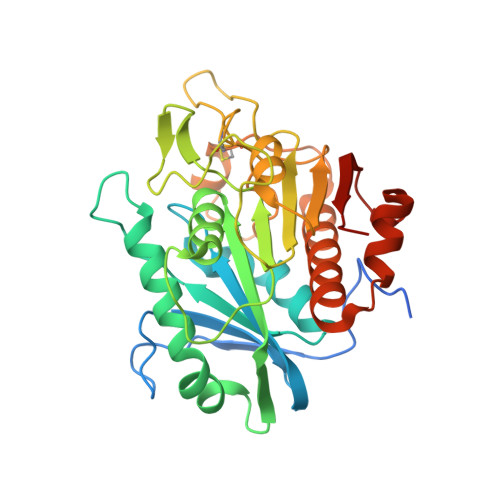A structure-function analysis of chlorophyllase reveals a mechanism for activity regulation dependent on disulfide bonds.
Jo, M., Knapp, M., Boggs, D.G., Brimberry, M., Donnan, P.H., Bridwell-Rabb, J.(2023) J Biological Chem 299: 102958-102958
- PubMed: 36731794
- DOI: https://doi.org/10.1016/j.jbc.2023.102958
- Primary Citation of Related Structures:
8FJD - PubMed Abstract:
Chlorophyll pigments are used by photosynthetic organisms to facilitate light capture and mediate the conversion of sunlight into chemical energy. Due to the indispensable nature of this pigment and its propensity to form reactive oxygen species, organisms heavily invest in its biosynthesis, recycling, and degradation. One key enzyme implicated in these processes is chlorophyllase, an α/β hydrolase that hydrolyzes the phytol tail of chlorophyll pigments to produce chlorophyllide molecules. This enzyme was discovered a century ago, but despite its importance to diverse photosynthetic organisms, there are still many missing biochemical details regarding how chlorophyllase functions. Here, we present the 4.46-Å resolution crystal structure of chlorophyllase from Triticum aestivum. This structure reveals the dimeric architecture of chlorophyllase, the arrangement of catalytic residues, an unexpected divalent metal ion-binding site, and a substrate-binding site that can accommodate a diverse range of pigments. Further, this structure exhibits the existence of both intermolecular and intramolecular disulfide bonds. We investigated the importance of these architectural features using enzyme kinetics, mass spectrometry, and thermal shift assays. Through this work, we demonstrated that the oxidation state of the Cys residues is imperative to the activity and stability of chlorophyllase, illuminating a biochemical trigger for responding to environmental stress. Additional bioinformatics analysis of the chlorophyllase enzyme family reveals widespread conservation of key catalytic residues and the identified "redox switch" among other plant chlorophyllase homologs, thus revealing key details regarding the structure-function relationships in chlorophyllase.
- Department of Chemistry, University of Michigan, Ann Arbor, Michigan, USA.
Organizational Affiliation:

















